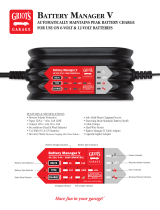
INSTRUCCIONES DE USO
H
Configuraciones del cargador de baterías
Al realizar una adecuada conexión de la batería (consulte
la Sección F o G, según corresponda), conecte el cable
de alimentación de CA en la toma de CA. Todos los LED
de la unidad se encenderán momentáneamente; luego,
únicamente los LED correspondientes a la configuración
de carga deben quedar encendidos. En este momento el
cargador se encuentra en Modo de espera.
Si se enciende un LED indicador de ERROR, desconecte
inmediatamente el cable alimentación de CA y determine
la causa de la alarma. La luz POLARIDAD indica un error
en la conexión por polaridad inversa, mientras que la luz
ERROR indica la detección de una falla en la batería, tal
como un cortocircuito en la conexión.
Para cargar una batería:
1. Seleccione una configuración de carga de voltaje
para la baterí. La configuración predeterminada
se encuentra en modo 12 V, que corresponde a la
mayoría de las aplicaciones de carga. Para cargar en
modo 24 V, presione el botón de voltios hasta que se
encienda el LED “24 V”.
2. Seleccione una configuración de tipo de batería. Para
cargar baterías inundadas de ácido estándar y libres
de mantenimiento, presione el botón de tipo de batería
hasta que se encienda el LED “STD”. Para cargar
baterías AGM, presione el botón tipo de batería hasta
que se encienda el LED “AGM”. Para cargar baterías
de células de gel, presione el botón tipo de batería
hasta que se encienda el LED “GEL”.
3. Seleccione una velocidad de carga de batería. Las
baterías pequeñas que se encuentran en aplicaciones
de jardinería, motocicletas o vehículos todo terreno
deben cargarse en la configuración de velocidad de
carga más baja posible.
4. Presione el botón “CHARGE” y se encenderá el
LED indicador de carga. El cargador comenzará
automáticamente el proceso de carga hasta
completarlo. Si presiona el botón “CHARGE” en
cualquier momento durante la secuencia de carga, el
cargador detendrá la carga y regresará al Modo de
espera.
Nota: Si se encienden los LED de ERROR,
desconecte inmediatamente el cable alimentación
de CA y determine la causa de la alarma. Para ver
una la lista de condiciones que pueden causar esta
advertencia, consulte Características adicionales. Si se
observa “Ohc” en la pantalla, el cargador ha entrado
en modo de protección contra sobrecalentamiento.
Consulte Características adicionales para ver más
detalles.
Nota: El cargador está diseñado para proteger contra
fallas y cortocircuitos (consulte Características del
cargador de baterías). Si la batería a cargar tiene
un voltaje de circuito abierto de menos de 1 V, el
cargador indicará una falla. Si, luego de desconectar
la unidad, controlar las conexiones y verificar todas
las configuraciones, determina que el problema que
causa la condición de “falla” es el voltaje de la batería
inferior a 1 V, puede anular la protección del cargador
manteniendo presionado el botón “CHARGE” durante
3 segundos. El cargador comenzará la secuencia de
carga y, suponiendo que no haya otros inconvenientes
que causen la indicación de una falla, completará el
proceso de carga y se apagará cuando la batería se
haya cargado por completo.
5. Cuando la batería esté a punto de cargarse
completamente e ingrese a la Fase de finalización, se
encenderá el indicador verde de CARGA COMPLETA
y el indicador de CARGA EN PROGRESO parpadeará.
En esta fase, si el tiempo es un factor crítico, la batería
puede ponerse en servicio si va a utilizarse en una
situación de carga, tal como en un vehículo que será
utilizado de inmediato. Para alcanzar el 100% exacto
de la carga, el cargador debe permanecer conectado
hasta que llegue a la Fase de reposo, cuando solo está
encendido el indicador verde de CARGA COMPLETA.
6. Cuando finalice con el proceso de carga, desconecte
el cable de alimentación CA de la salida, luego
desconecte los cables de CC de la masa del vehículo
(si realiza la carga con la batería en el vehículo) y
la batería, en secuencia inversa al procedimiento de
conexión.
Indicadores de modo Indicadores de tipo de batería
Indicadores de velocidad de batería
Pantalla
Indicador de carga
Indicador de carga completa
Indicador de error
Selector Iniciar/Detener carga
Selector de información de pantalla
Indicadores de información de pantalla Indicador de polaridad inversa
Selector de modo
Selector de tipo de batería
Selector de velocidad de carga
STAT US CENTER
CONTROL CENTER
CHARGING IN PROGRESS
CHARGING COMPLETE
POLARITY ERROR
MODE
12VSTD 2A
24VAGM 6A
GELPWR10A
TYPE RATE
% CHARGE VOLTAGE
CHARGE
123
PL2410




















